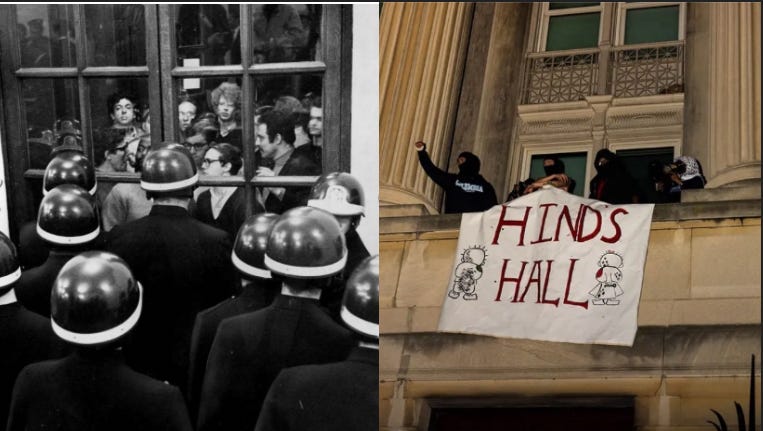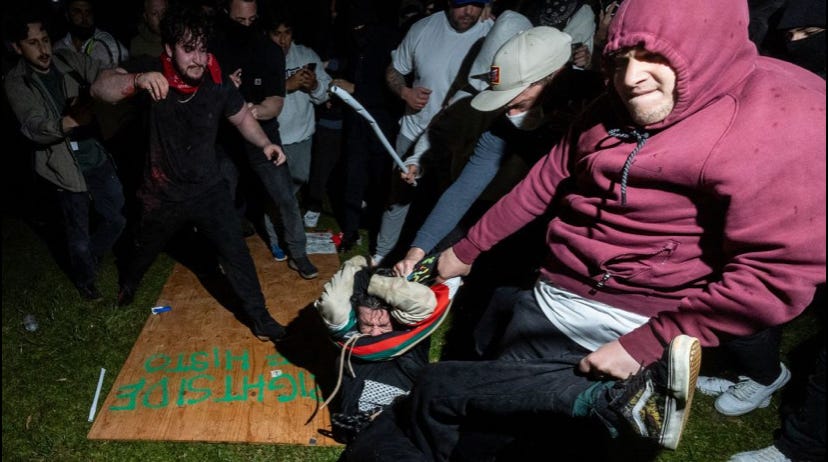Student Resistance Against Death and Destruction
Discussing the Gaza Solidarity Encampments and the Antagonisms of their Universities
Resistance is a staple of United States’ history. From demonstrations, like marches and sit-ins, to violent acts of retaliation, such as guerilla wars and riots, every major societal shift that has happened in this country was brought about via mass resistance against a governing body that created the material conditions for said resistance. In the later half of the 20th century, the voices of the youth would take the lead in engaging in these acts of resistance in order to make achievable demands of their respective governments. Currently, college campuses throughout the country have engaged in a precedent action to combat the imperialist desires of not just their university leadership, but political leadership as well, setting up encampments.
Starting back in April at Columbia University, hundreds of students took to the lawn of the southern quad of the university and began pitching tents, establishing the first of what would be referred to as the “Gaza Solidarity Encampment.” As of 15 May, more than 110 campuses have erupted with these solidarity encampments, all with similar goals in demanding the leadership of their respective universities to divest their dollars from Israel and companies with direct ties in helping Israel commit their genocide against the Palestinians.
The practice of students occupying areas of their universities for political purposes is not unprecedented. The Vietnam War sparked a similar anti-imperialism flame among American college students as well. Beginning in 1963 at the University of Wisconsin, demonstrations voicing disdain for the U.S. involvement in Vietnam would expand to around 1,300 campuses after the deaths of four Kent State University student protestors in 1970.

These protests would be organized by both students and faculty targeting various aspects of the State’s pro-war agenda. This included teach-ins and sit-ins, occupying administration offices for the purposes of ending the draft, even going so far as to trap and question the then Secretary of Defense, Robert McNamara, about the purpose of the war. Dow Chemicals, the corporation responsible for developing Napalm, was also subject to protest as many students at the University of Wisconsin would demand the end to the recruitment relationship between the company and school. The company’s return to the campus in 1967 would spark more protest that would see violent responses from police. The civil unrest that had lasted for a decade would see the U.S. troop removal process begin in 1973 via the Paris Peace Accords.
Though the response to the Vietnam War is typically used as the pinnacle example of the anti-imperialist sentiments of the youth in this country, the encampments today can be directly compared to the encampments that started in 1985 against apartheid South Africa.
Convergence Magazine would interview activist, Gerald Lenoir, about the current encampments and his involvement in past protests. Not only did Lenoir recall his time protesting against the War in Vietnam but how the students rallied together for the purposes of divesting from an apartheid regime. Demonstrations began at Columbia University, however it was Cornell University that was the first to erect an encampment for such a purpose.
From that point, around 50 colleges would have similar encampments and a boycott, divest, and sanction movement against apartheid South Africa was created. The result of this movement was the introduction of the Anti-Apartheid Act in 1986 that not only made its way to the White House, but had enough support in Congress to overrule President Reagan’s veto of the bill. Even after the passage of the bill, students kept on with the encampments resulting in a few of the universities divesting from South Africa.
Even with this recent history of students challenging what they understand to be the harmful desires of the State, the large establishment media (supporting both halves of the duopoly) has done its due diligence in propagandizing the American people about the nature of these protests today and what they are fighting to end. To the uninformed, these protests are full of violence, unreasonable, unfocused and composed of outside aggressors. This is most definitely not the case.
The occupation of the Hamilton Hall in Columbia University (now named Hind’s Hall paying homage to the brave 6-year old Palestinian girl who witnessed her family be gunned down by the IDF, called for help, and was later killed by the IDF while making that call) is again reminiscent of the rightful student protest against the Vietnam War. The violent response from police is also reminiscent of that time.
Recent reporting has found that almost 3,000 people have been arrested or detained since these encampments spread throughout the nation. Of those arrested include students, faculty and bystanders with no affiliation to the encampments in any capacity. These arrest are done with the support of the school administration who are proving to value their overvalued endowment funds more than the well-being of their own students and faculty and more than the lives lost to an ongoing genocide.
Not only must these protestors deal with state-sanctioned violence, but also violence from counter-protestors who support the genocide in occupied Palestine. Some of the most horrific scenes of violence surrounding these encampments are tied directly to the counter-protestors attacking students.
The student protestors at the University of California Los Angeles (UCLA) were viciously attacked by Pro-Israel agitators, many of whom had no affiliation to the university on a student or faculty capacity. On April 30, the encampment residents would experience a night of terror as outside aggressors would bombard the barriers of the encampments with blunt objects and pick off lone students with brutal group assaults.
Reporting from CNN identified key agitators ranging from an 18-year old high school student to a 42-year old with a history of instigation to college students from a completely different campus. These are the outsiders causing violence and chaos at these encampments and yet the police response was lackluster to say the least, being slow to respond to the violence and allowing a majority of the counter-protestors to freely walk away from the scene as the pandemonium subsided. Police also had no reporting on any injuries sustained by either side, however, those that were in the encampments were left with over 150 people combating the effects of pepper-spray and more than 25 people seeking aid for head injuries.
What’s been demonstrated with the responses to these encampments is a blatant attack on free speech when it particularly is voiced against imperialism, with the state, the university, and the police working together to accomplish this suppression.
University of Pennsylvania, for example, after clearing out an encampment using police force (at least 30 students were arrested) placed six students with affiliation to their respective encampments into a mandatory leave of absence restricting the students' movement on and to campus. Their justification being the encampments are unsafe and disruptive. Other tactics used by different universities include threatening academic sanctions, the revocation of student housing, and siccing campus police on the students. While the universities use the police as a threat and tool to disrupt these protests, their long-standing partnership with the Military Industrial Complex (MIC) can likely explain why these universities would rather arrest their students and ruin their futures as opposed to ending direct and indirect financial relationships with a terrorist state.
Dating all the way back to the end of World War II, writer Nicolas Turse, would recall how the Department of Defense (DoD) established research contracts with six civilian universities (the Massachusetts Institute of Technology, the California Institute of Technology, Harvard University, Columbia University, the University of California at Berkeley and Johns Hopkins University), each receiving $10 million in 1946. This “golden triangle” between the military, technological advancement, and universities expanded.
In 2002, it was reported by the Association of American Universities (AAU) that upwards of 350 universities had federal contracts with the Pentagon for research purposes. These universities also received over 60% of the DoD’s defense research funding, making the DoD the third largest university research funder. Since Eisenhower’s warning in the 1960s regarding the consequences of boosting a Military Industrial Complex, DoD university research funding would experience a 100 times increase from around $550 million to over $50 billion today, with a peak of $66 billion recorded in 2004.
These universities, especially the “prestigious” institutions, are beholden to the desires of the MIC. That complex demands financial and military support for Israel, both of which the student protestors refuse to comply.
Though a number of the Gaza Solidarity Encampments were disbanded by force, others have come to amicable agreements between the students and the university leaders. These compromises include promises to hold a divestment vote in the future and promises to publicize their respective university’s investments. Other schools, such as San Francisco State University and UC Berkeley, committed to pulling investments from weapons manufacturers and investigating other “human-rights-investment” strategies. Even the president of Sonoma State University risked his career and suffered a temporary removal from his position for declaring that the school would no longer pursue collaborations with Israeli-affiliated academic research.
Compared to the demand of the Palestinians, these are hardly victorious gains, however, many students and faculty alike carry optimism that as these protests continue a material demand can be met. Their eyes have been opened to the symbiotic relationship between their universities and the military as well as their institutions' lack of hesitation to destroy their lives for the sake of the MIC. It is that enlightened view, we can hold revolutionary optimism that the future generations of leaders may finally break the cycle of support for the imperialist desires of the State.




